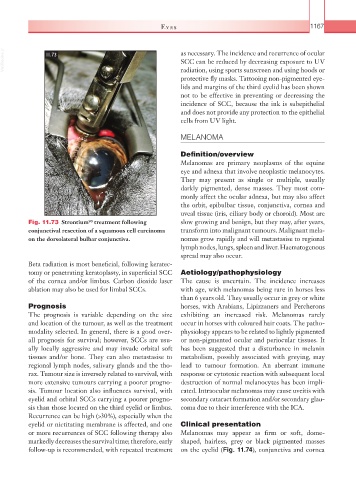Page 1192 - Equine Clinical Medicine, Surgery and Reproduction, 2nd Edition
P. 1192
Eyes 1167
VetBooks.ir 11.73 as necessary. The incidence and recurrence of ocular
SCC can be reduced by decreasing exposure to UV
radiation, using sports sunscreen and using hoods or
protective fly masks. Tattooing non-pigmented eye-
lids and margins of the third eyelid has been shown
not to be effective in preventing or decreasing the
incidence of SCC, because the ink is subepithelial
and does not provide any protection to the epithelial
cells from UV light.
MELANOMA
Definition/overview
Melanomas are primary neoplasms of the equine
eye and adnexa that involve neoplastic melanocytes.
They may present as single or multiple, usually
darkly pigmented, dense masses. They most com-
monly affect the ocular adnexa, but may also affect
the orbit, epibulbar tissue, conjunctiva, cornea and
uveal tissue (iris, ciliary body or choroid). Most are
90
Fig. 11.73 Strontium treatment following slow growing and benign, but they may, after years,
conjunctival resection of a squamous cell carcinoma transform into malignant tumours. Malignant mela-
on the dorsolateral bulbar conjunctiva. nomas grow rapidly and will metastasise to regional
lymph nodes, lungs, spleen and liver. Haematogenous
spread may also occur.
Beta radiation is most beneficial, following keratec-
tomy or penetrating keratoplasty, in superficial SCC Aetiology/pathophysiology
of the cornea and/or limbus. Carbon dioxide laser The cause is uncertain. The incidence increases
ablation may also be used for limbal SCCs. with age, with melanomas being rare in horses less
than 6 years old. They usually occur in grey or white
Prognosis horses, with Arabians, Lipizzaners and Percherons
The prognosis is variable depending on the size exhibiting an increased risk. Melanomas rarely
and location of the tumour, as well as the treatment occur in horses with coloured hair coats. The patho-
modality selected. In general, there is a good over- physiology appears to be related to lightly pigmented
all prognosis for survival; however, SCCs are usu- or non-pigmented ocular and periocular tissues. It
ally locally aggressive and may invade orbital soft has been suggested that a disturbance in melanin
tissues and/or bone. They can also metastasise to metabolism, possibly associated with greying, may
regional lymph nodes, salivary glands and the tho- lead to tumour formation. An aberrant immune
rax. Tumour size is inversely related to survival, with response or cytotoxic reaction with subsequent local
more extensive tumours carrying a poorer progno- destruction of normal melanocytes has been impli-
sis. Tumour location also influences survival, with cated. Intraocular melanomas may cause uveitis with
eyelid and orbital SCCs carrying a poorer progno- secondary cataract formation and/or secondary glau-
sis than those located on the third eyelid or limbus. coma due to their interference with the ICA.
Recurrence can be high (>30%), especially when the
eyelid or nictitating membrane is affected, and one Clinical presentation
or more recurrences of SCC following therapy also Melanomas may appear as firm or soft, dome-
markedly decreases the survival time; therefore, early shaped, hairless, grey or black pigmented masses
follow-up is recommended, with repeated treatment on the eyelid (Fig. 11.74), conjunctiva and cornea

